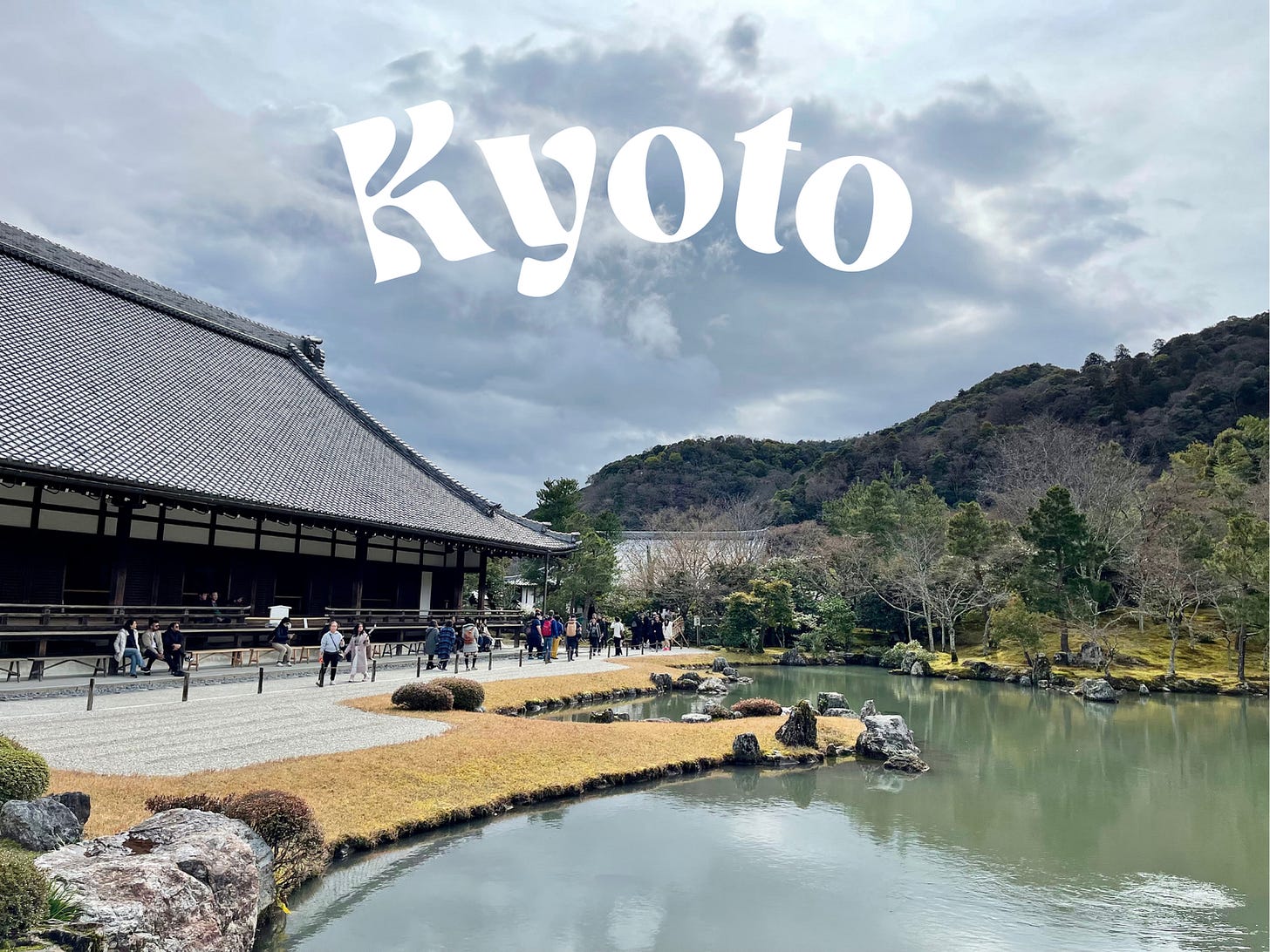Full Guide: Kyoto, Japan
Immerse yourself in the quintessential Japanese experience - from thousand-year old temples and shrines to the mothership of matcha.
Traveler Tips:
First thing’s first, there are over 1600 temples and 400 shrines in and around Kyoto. Don’t be overwhelmed, just be selective about what is most important for your time here.
We only stayed 2 nights here because we wanted more time in Tokyo after but would recommend 3 nights as it felt a bit jam-packed. There is a lot to see, do, and eat in this special town.
Going to Japan is definitely an other-worldly experience where you are in their country, so just be mindful of this. This may mean getting a little out of your comfort zone because it is quite different from American customs in some ways, but it’s all part of the adventure.
The main language spoken is Japanese of course, but most people in the service industry do speak English. Announcements are given in English at the train stations and on board. When in doubt, there are usually convenient ways to order food or drinks via menus with pictures. Modern technology makes all this much easier to manage. We were able to get a few key phrases down before the trip via the free DuoLingo app — mainly “biru kudasai” (beer please).
Pack comfortable walking shoes. This is the best way to get around and get a feel for the ancient history and culture of this city. Plus most of the shrines and attractions have a good amount of walking as part of the experience. Night time strolls through the old town are also such a vibe. Really hadn’t experienced anything like it before, even in the rain.
Japanese Yen is the main currency, as most places do not take US Dollars, so be sure to get a bit of cash for street merchants and shrine donations. Otherwise everyone uses credit cards or ApplePay.
We’ve put together a dedicated section with tips for taking the bullet train. It’s really efficient and awesome once you’re on board, but figuring that out in the Tokyo or Kyoto stations can be a bit confusing. More on that below.

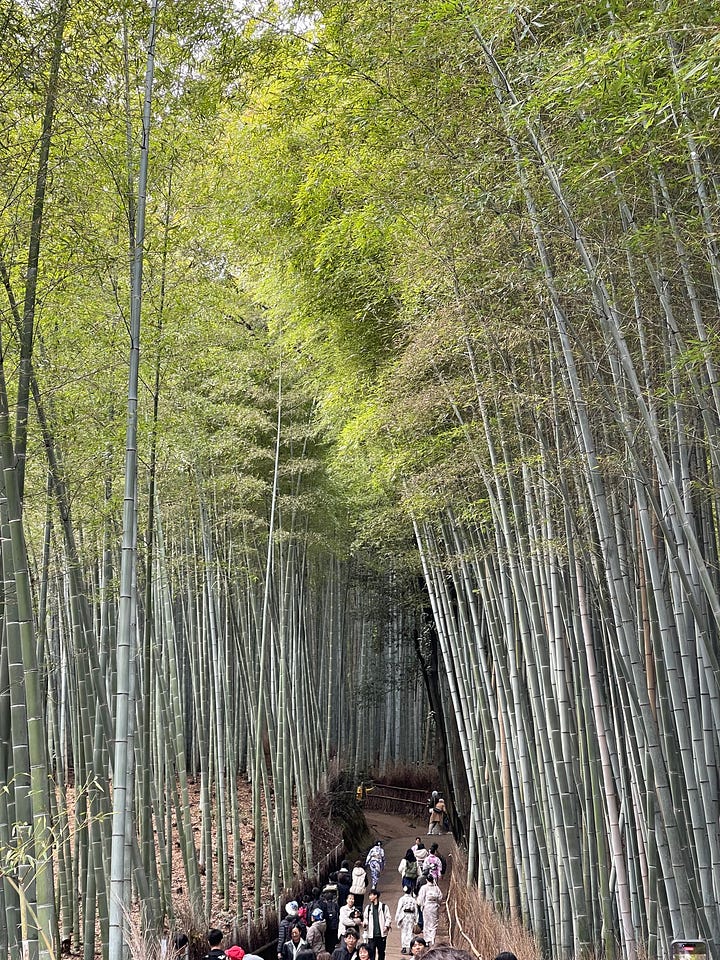
Must See / Do:
st-see shrine on Inari Mountain with around 10,000 Tori gates, some dating back to 711 A.D. The scale and history of the site amidst the forest are awe-inspiring, and it's open year-round with no admission fee.
For hikers, wear your athleisure and plan for the full 2.8-mile loop to the top, offering stunning views of the city. The moderately challenging hike takes about 1.5 to 2 hours, though we didn’t complete it due to time constraints. Whether hiking or just exploring, visit early in the morning to avoid crowds and heat. Along the way, you’ll find small shops for souvenirs or snacks.
Arashiyama Bamboo Forest: We took an Uber straight here after Fushimi Inari, arriving around 11:30am. Even in February it was starting to fill up with tour groups and selfie-stick crowds by then, as it’s also open year-round and free admission.
This unique walk through nature was an unforgettable experience, reminiscent of California redwoods with the towering bamboo trees making you feel humble in their presence. The swaying bamboo adds a calming touch, though the entrance is more of a photo spot with many tourists. While the trail extends further, we cut it short due to the walking distance. You can book guided tours, but we preferred exploring at our own pace.
We visited Tenryu-ji Temple and gardens on the walk out of the forest, which is also a UNESCO World Heritage Site. This was less crowded and very pleasant. The zen garden was just that - very peaceful and impeccably well kept with a large pond. Definitely recommend paying the small fee to see this.
Kinkaku-ji Temple: This gold-leaf covered UNESCO World Heritage shrine is one of the most well known in the city and looks so beautiful and impressive. We didn’t have time to see this one, but it was in our top list. It has a very peaceful setting on a pond.
Nintendo Museum: Fun fact.. Nintendo’s headquarters are in Kyoto. We went to the Nintendo store in the Kyoto Takashimaya SC Department Store since the museum wasn’t open yet. If you’re a fan of video games, we’d recommend checking out the museum over the store, as it mainly had toys and merchandise for kids. The museum looks awesome.
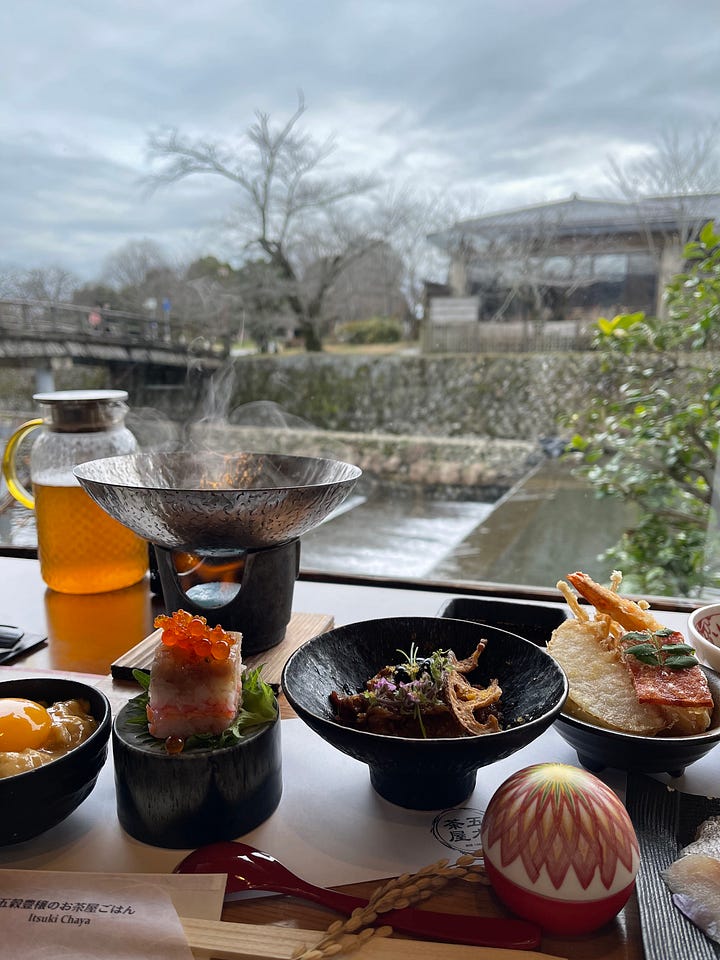

Must Eat:
Nishiki Market: A must-visit for food lovers in Kyoto, this bustling street is lined with street vendors and small restaurants, offering a variety of local bites like yakitori, tempura, gyoza, and crab legs. Though narrow and often crowded, the market’s side streets provide quick escapes. Don’t miss the 100 Yen ($1) sake shots tucked away in hidden alcoves.
Itsuki Chaya Arashiyama Honten: We had lunch here and loved it. Be sure to make a reservation in advance, as it’s a small restaurant and often fully booked with locals. Located in Arashiyama Park along the river, it’s a short walk from the main streets and Arashiyama Bamboo Forest. The views of the river are really nice, and the seasonal set menu was delicious after we had worked up our appetite walking around all morning. It was about $27 per person (4,000 Japanese Yen) during our visit and included individual portions of: shabu-shabu hot pot, beef sukiyaki rice bowl, seafood chirashi/sushi, yuzu flavored bowl of rice topped with crab, shrimp and seasonal tempura, and a golden egg rice bowl.
Monk: Not exactly what comes to mind when you think of the best eats in Kyoto, but this intimate and humble place serves some of the best wood-fired pizzas. It was featured on Netflix’s Chef’s Table and is known amongst chefs and foodies. Reservations are released 2 months in advance, so plan ahead. Unfortunately we did not, so we didn’t get to eat here but it was in our top hit list.

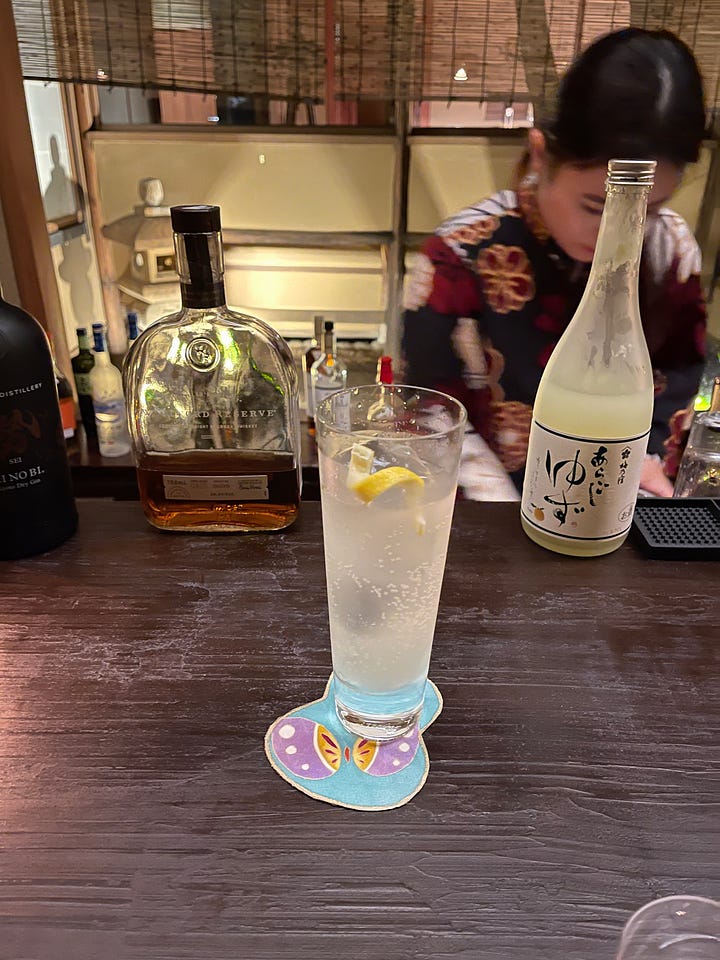
Where to Drink:
Gion Tsujiri: As mentioned, Kyoto is the mothership of matcha, so you will have no shortage of opportunities to eat, drink, and buy it. If you can’t take a trip to south of the city to Uji, where the highest grade matcha is produced, you can still find great shops around downtown Kyoto that sell it. This tea shop was worth mentioning as it was one of the most impressive ones we visited. The main floor is for retail, and they also have an upstairs cafe for matcha food and desserts. We bought a few matcha cookies to bring home as well as some varieties of matcha tea and a bamboo whisk for making it at home.
The Bar at Sowaka: While this bar is only for hotel guests staying at Sowaka, it was one of the coolest and most intimate we visited. With only four seats set low to the ground and a sunken back bar, the layout feels like something from a storybook. The bartender, who enters through a tiny door, specializes in Japanese highballs and sours but can customize drinks to your taste.
Afternoon Tea at Aman Kyoto: There are two restaurants at Aman Kyoto, both of which can take reservations in advance and open to the public. Since Afternoon Tea is an important Japanese custom, we decided to experience it here and would recommend it for a bit of luxury during your time in Kyoto. It’s a short drive outside of the main town and feels very secluded as it’s surrounded by nature. The Living Pavilion is the main restaurant where Afternoon Tea takes place and has a beautiful indoor and outdoor setting with fireplaces. The matcha is prepared tableside in front of you and served with an assortment of delicate sweets and snacks that change seasonally.
Bar Rocking Chair: We didn’t get a chance to hit up too many cocktail bars in Kyoto since the trip was short and we were tired from all the walking around, but this one is definitely on our radar for the next visit. It’s a warm, cozy local spot tucked away with top-notch cocktails by a pro team.
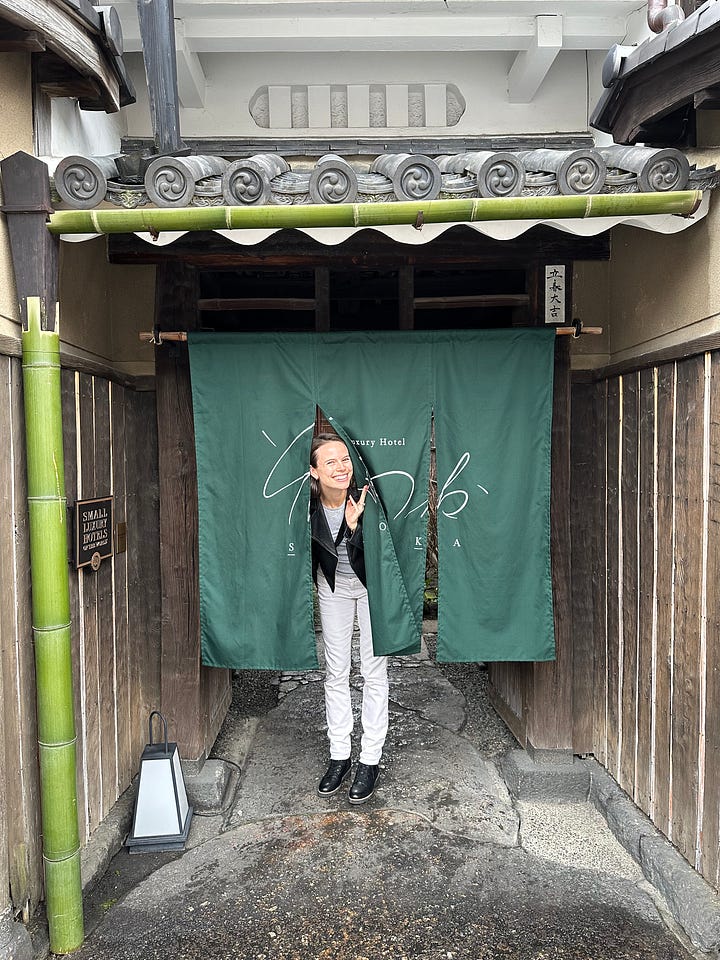
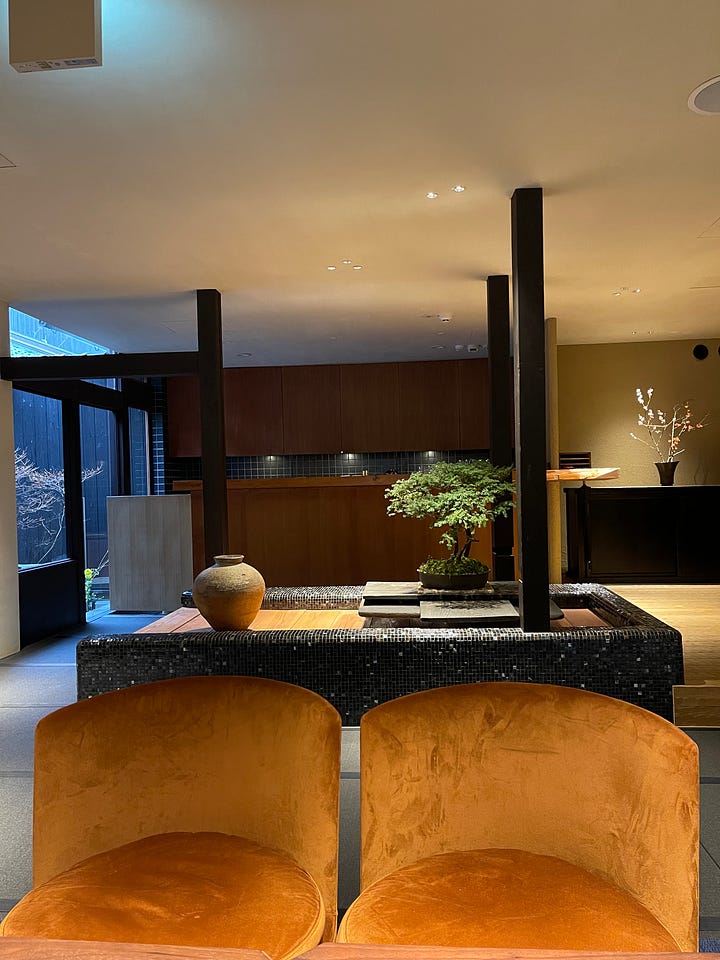
Where to Stay:
Sowaka Kyoto: rates from $500+ per night, depending on season.
We stayed during the week (Mon-Weds), and got a good deal through Booking.com around $500 per night, with breakfast included. Keep a close eye on the booking sites and plan in advance.
This hotel was our favorite of the entire trip - the service was so personalized and considerate. It was so special to stay in a traditional ryokan, which was something a first experience for us, and the rest of our hotels on the trip were more modern.
This historic building only has 23 rooms and you really feel the intimacy of it. It had heated floors (great for February!), separate sitting room and spacious shower / wooden bath tub. There are beautiful zen gardens throughout, and it feels almost like a maze walking through the sliding doors to get to the various spaces or back to your room.
Get the breakfast included! It’s the most impressive traditional Japanese breakfast and if you’ve never had it, it’s definitely worth doing one time. You can choose each morning Japanese or American breakfast at the restaurant, and they do both exceptionally well.
Great central location in Gion district, just a couple blocks away from the Yasaka Shrine, a quick walk to the train station and the main parts of town.
They have a lot of interesting private experiences and tours to offer, but we didn’t do any of them and preferred exploring on our own.
Ace Hotel Kyoto: rates from $250+ per night
We originally booked the Ace but cancelled after finding a great rate at Sowaka, which offered the more authentic ryokan experience. If that’s not as much of a priority for you (and if the rates don’t go down at Sowaka, because I wouldn’t suggest paying $1,000 per night to stay there), this is a solid option with a good central location. They also just were awarded 1 Michelin Key 🔑.
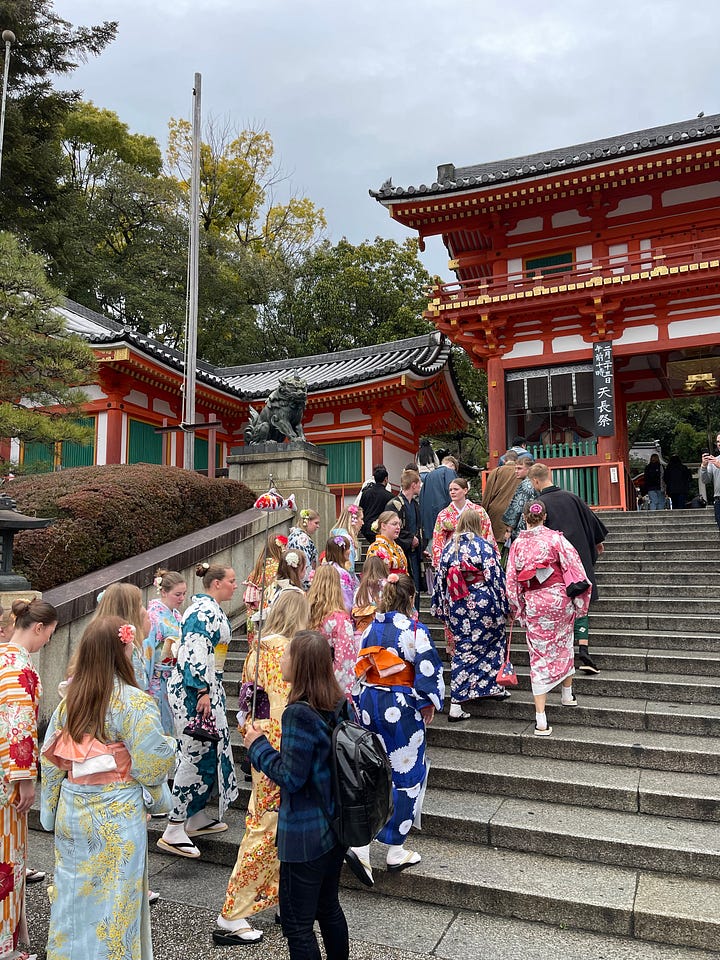
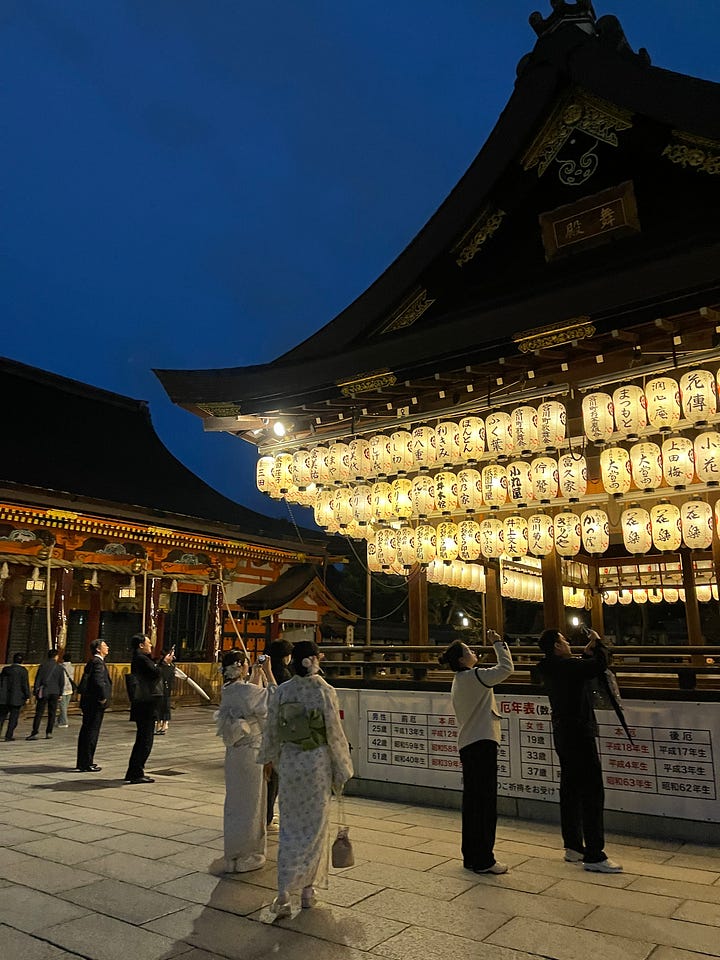
Hidden Gems:
nuunu Kyoto: We stumbled upon this amazing local art gallery located on the 4th floor of the Kyoto Takashimaya SC Department Store after checking out the Nintendo store. There are tons of artworks - both framed and printed - by local artists from Japan as well as other parts of Asia too. We definitely got lost in here for about an hour or so - it was like crate digging going through all the sketches and prints they have in boxes. Each print has the name of the artist and a little bit about them and their IG handle. It seems like nuunu offers a way for up-and-coming artists to get discovered, so the prices are really affordable. We bought two prints that we brought home.


Bullet Train (Shinkansen) Tips:
Tokyo Departure Stations: You can take the Shinkansen bullet train from Tokyo Station or Shinagawa Station. It takes about 2h 10m to reach Kyoto.
Purchasing Tickets: You can buy tickets at the station the day of since trains leave for Kyoto multiple times every hour. It was more confusing to buy them online in advance, and this gives you flexibility with timing. The digital ticket kiosk is easy to navigate (when you select English). Just make sure you get there an hour or so before your desired departure time so you have plenty of time to navigate everything.
Be sure to keep your ticket stubs on you until after you have arrived to your destination station. You’ll need to insert the ticket stub to exit the turnstile.
Selecting Seats: If you are carrying medium to large-sized luggage with you, it’s best to book a reserved seat option (shiteiseki). This way you can reserve seats at the end of a train car that has exclusive space for your luggage. Regular seats don’t have much stowage space for luggage. We also opted for the Green Car (i.e. premium cabin) that usually has 2 by 2 seating, more leg room and recline. Reserved Seat cost in the Green Car: ~$100-120 each way per person.
There is also a popular luggage shipping service to Kyoto so it arrives ahead of you but we decided against it because it complicates logistics a bit.
Important to keep in mind: on the way to Kyoto, we arrived with plenty of time at the station, but there weren’t any Reserved Seats on the train we wanted to take, since there are only a limited number for each train. We found seats on an earlier train, but that moved up our departure time and we had to navigate through Tokyo Station very quickly.
If you are going from Tokyo to Kyoto or Osaka, get the seats on the right side (in the direction of travel) for a beautiful drive-by shot of Mount Fuji.
Food: Highly recommend to buy a bento box from one of the vendors at the station. They are everywhere, even some options are on the train platform. The selection is vast when it comest to the type of bento box (meat vs. fish, raw vs. cooked, etc.) and there’s usually pictures to give an idea of what each comes with. It’s kind of like a game to pick one that looks good from the packaging and see what you get inside. They’re around $10 and honestly so delicious.
Drinks: You can purchase in the station but you can also buy different types of beverages, including alcoholic drinks, on the train. There’s a QR code in front of your seat that directs you to an online ordering system. A woman delivered the beers crazy fast, and they were ice cold. Something so simple and seamless yet so awesome.
Packing Essentials:
Google Translate app (iOS, Android): this came in handy so many times when taking pictures of menus and having them instantly translated for us, if there wasn’t an English menu, or when trying to converse with local taxi drivers etc.
Shoes: Comfortable walking shoes (bonus points if they’re fashionable too)
Clothes: Depends on time of year but generally, layering is the best bet. Many places are very warm indoors, even when it’s a cool 60-degrees outdoors.
Lightweight jacket of some kind unless you go in winter and need something heavier. I was good with a leather jacket and layering.
Accessories:
Umbrellas: Don’t worry about bringing an umbrella. All the hotels provide them, and everyone is really courteous about the honor system of not taking someone else’s umbrella.
Power adapter: unless you stay in a very quaint bed & breakfast or need to bring a specific item from home, you’ll be fine using what the hotel provides. Many of them have adapters if you need, and when it comes to charging your phone, most have USB ports.
Portable phone charger: Bring one for all-day long excursions, especially if you don’t plan on going back to the hotel to reset before night time.
Have you been to Kyoto? Any musts that we need to add to our list? Let us know in the comments!






